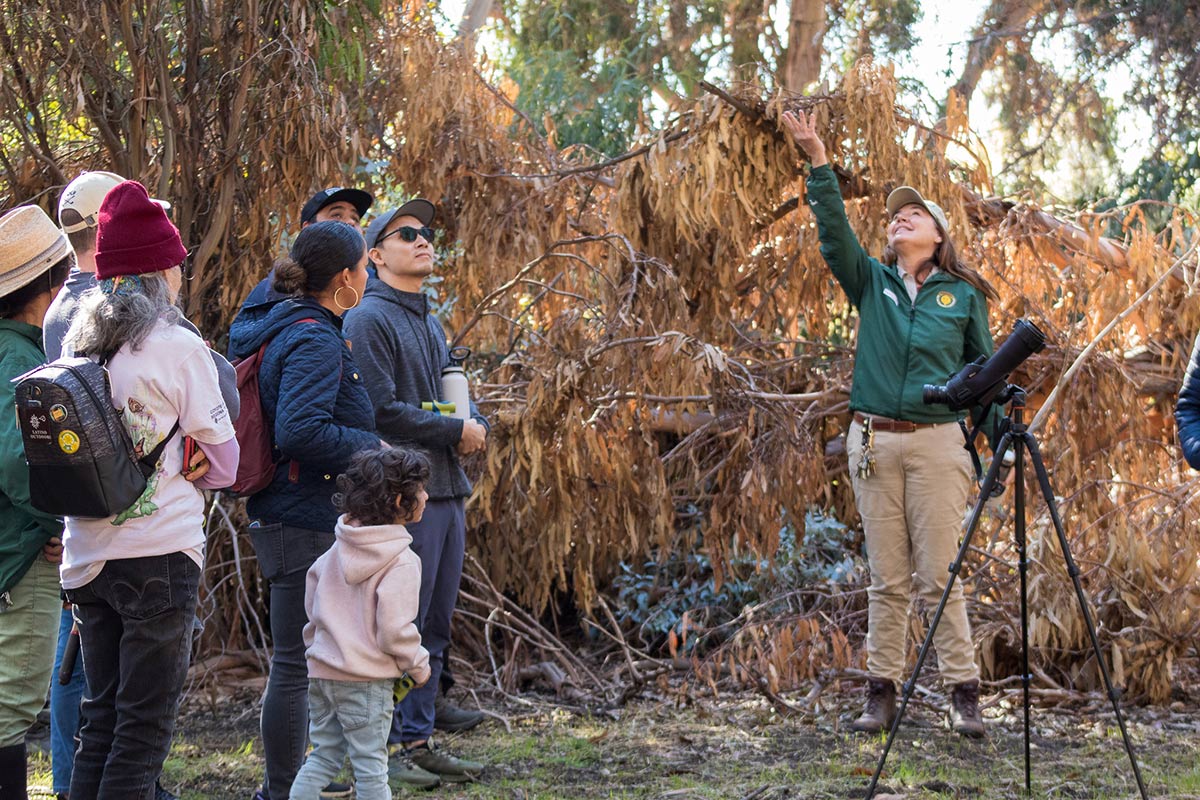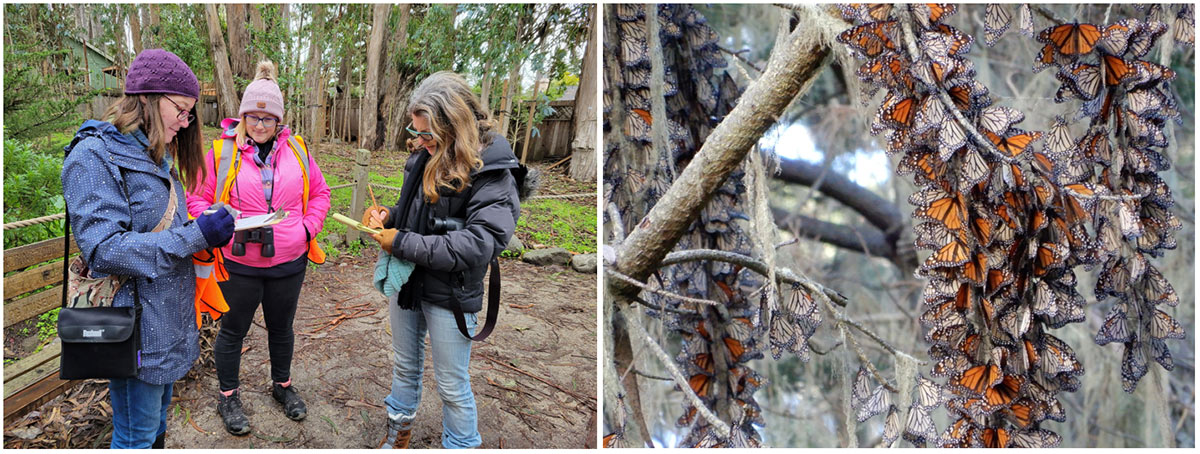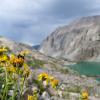In autumn, as temperatures drop, days shorten, and milkweed plants die back, monarch butterflies (Danaus plexippus) journey from across North America to special locations along the Pacific coast and central Mexico. Here, they cluster together in sheltered groves, sometimes by the thousands, to rest and survive the winter.
This breathtaking phenomenon is one of nature’s most awe-inspiring sights. Monarch butterflies gather at many of the same overwintering sites each fall and winter. Despite being four, five, or six generations removed from the butterflies that last occupied these sites, migratory monarchs know exactly where to go. Fortunately, so do we!
The best part? Several overwintering groves are open to the public. Whether you’re a lifelong nature enthusiast or a curious first-time visitor, November and December offer the perfect opportunity to witness monarch aggregations up close.

Where to see monarchs in California
Most monarchs living west of the Rocky Mountains migrate to the California coast to overwinter. While some sites are on private land, several are located within state parks, city preserves, or natural areas that welcome members of the public.
If you would like to marvel at overwintering monarchs, here are a few sites we recommend for visitors:
- Lighthouse Field State Beach (Santa Cruz County). A Monterey cypress and eucalyptus grove that usually hosts sizable displays of overwintering monarchs. The park forms the northern boundary of Monterey Bay and is one of the last open headlands in California. Surfers, tourists, birds, and monarch butterflies are all drawn to this area. Free parking is available in paved lots along West Cliff Drive and along nearby streets. Restrooms available.
- Natural Bridges State Beach (Santa Cruz County). Located near Lighthouse Field, this is another consistent western monarch overwintering site. There are interpretive programs for the public, and the site can be accessed via the Monarch Trail–a shaded, wooden boardwalk with a gentle grade that leads to an observation deck. Pay a small parking fee at the entry kiosk, or find free parking along nearby streets. Restrooms available.
- Pacific Grove Monarch Sanctuary (Monterey County). Managed by the city nicknamed “Butterfly Town, USA”, this grove features wide, paved paths and docent-led tours. Parking is limited; entry to the grove is free. Restrooms available. If you have time, make a stop at the Pacific Grove Museum of Natural History which is just a short drive away.
- Pismo State Beach Monarch Butterfly Grove (San Luis Obispo County). Another consistent western monarch overwintering site along the central coast. This grove frequently hosts sizable monarch clusters. Parking is limited; entry to the grove is free. Docent tours are available, and the trails are wide, flat, and generally even. Limited restroom facilities.
There are a several other overwintering sites with public access, such as the Goleta Butterfly Grove at Ellwood Mesa (Santa Barbara County), Ardenwood Historic Farm (Alameda County), Camino Real Park (Ventura County) and multiple sites within California State Parks. However, clusters of monarchs may be less common at these sites in years where monarch populations are particularly low.

Where to see overwintering eastern monarchs
Interested in seeing monarchs farther south? Explore Mexico’s monarch butterfly sanctuaries, where the eastern migratory population spends the winter.
How to plan your visit to see overwintering monarchs
Visit each park’s official website before you go for up-to-date information on hours, parking fees, and accessibility features. Some sites may charge vehicle day-use parking fees (usually $10–15), but free parking is often available nearby. Most monarch viewing areas have flat, paved, or packed dirt trails, and many offer benches or rest areas. There’s almost always shade available since the monarchs roost in trees.
A few accessibility resources that may be helpful to review prior to visiting include Access California and California State Parks: Accessible Parks for All.
When is the best time to see overwintering monarchs?
Monarchs typically start arriving at overwintering sites in October and remain through early February, depending on weather conditions. The peak viewing season is from mid-November through December. You won’t find monarch clusters at these sites between spring and early fall since monarchs will be dispersed across the landscape searching for nectar-rich flowers and milkweed (Asclepias spp.) — the type of plant that monarchs lay their eggs on and eat as caterpillars.
Plan your visit for a sunny morning or afternoon, when temperatures rise above 55°F — that’s when monarchs begin to flutter, bask in the sunlight, and fly around the grove. If you’d like to see monarchs clustered together, arrive a little earlier in the morning when it’s still cool from the night before or on an overcast day. Just know that clusters may be tricky to spot without some monarch movement to clue you in.
What to bring to an overwintering site
You don’t need much to enjoy the monarch spectacle, but a few simple items will make your visit even better:
- Binoculars (we recommend 8x42 or 10x50 magnification)
- Camera with good zoom and video functions
- Comfortable walking shoes and layered clothing
- Reusable water bottle and snacks
- Smartphone with the Project Monarch app
How to watch monarchs responsibly
Overwintering groves are delicate ecosystems, and monarchs can be disturbed by human activity. You can help protect them by following these simple tips:
✅ DO:
- Stay on marked paths and behind barriers.
- Leave pets at home or keep them on a leash, depending on park rules.
- Watch your step to avoid accidentally squishing a grounded monarch.
- Dispose of trash responsibly. Many animals are attracted to food waste and can become major predators of overwintering monarchs.
- Attend a docent-led event to learn more about monarch butterflies and what we can all do to help them.
- Tell a docent or site volunteer if you see a tagged monarch.
- Ask about volunteer opportunities if you live nearby.
🚫 DON’T:
- Touch or handle monarchs. California has a strict no-handling policy unless you are part of a permitted research study.
- Apply insect repellant or spray-products inside the grove.
- Release captive-reared monarchs at overwintering sites — this can spread disease and disrupt natural migration.
- Make excessive noise like playing loud music, yelling, or shouting. Calm environments improve the overall experience.
- Disturb trees or shrubs in the grove. Woody vegetation can take years to grow back.
By following these simple guidelines, you will help ensure monarchs and their overwintering habitat remain healthy and safe.

How many monarchs will there be at an overwintering site?
As the population of migrating monarchs has declined across North America, the number of butterflies at overwintering sites can vary. Hundreds or thousands of butterflies could occupy sites one year, and then the next there could be few to none. Some population “bounciness” is normal among insects, but it’s particularly concerning when a species has already experienced significant declines.
Trends at western monarch overwintering sites are published annually, and some land stewards post regular monarch count updates to their websites during the overwintering season. If you’re worried about not seeing monarchs, do some research before your trip to set realistic expectations.
Enjoy the magic and meaning of monarchs
Standing beneath a cluster of butterflies is a humbling experience. Each monarch you see has traveled many miles and faced numerous challenges before reaching its safe-haven among the trees.
The return of monarchs each fall is a reminder that small creatures can connect vast landscapes and far-flung communities.
As you visit overwintering sites this season, take a moment to look up, breathe in the scent of redwood, pine, or eucalyptus, and watch the sunlight turn thousands of orange wings into a living mosaic. You’re witnessing one of the world’s most extraordinary natural wonders — one that depends on all of us to protect it.
Ready to take action? Discover what you can do to help western monarchs.






